The effect of different factors on investment decision of enterprises in industrial parts
Attracting investment capital of enterprises into industrial parks has become an important task for
countries when building and developing industrial parks to meet the economic goals of the country.
To attract enterprises' investment capital into industrial parks, it is important to study what the
enterprises need and whether or not they have met the needs of the enterprises. This examination was
designed to analyze the factors affecting the investment decisions of enterprises in industrial parks in
Vietnam whereby serving as the basis for proposing recommendations to improve the efficiency of
attracting investment capital of enterprises in industrial parks in Vietnam. Research findings indicate
that some factors influencing enterprises' investment decisions in industrial parks include: Local
institutions, human resources, local advantages and infrastructure. Based on that analysis, the study
proposes several recommendations to attract investment in industrial parks in Vietnam
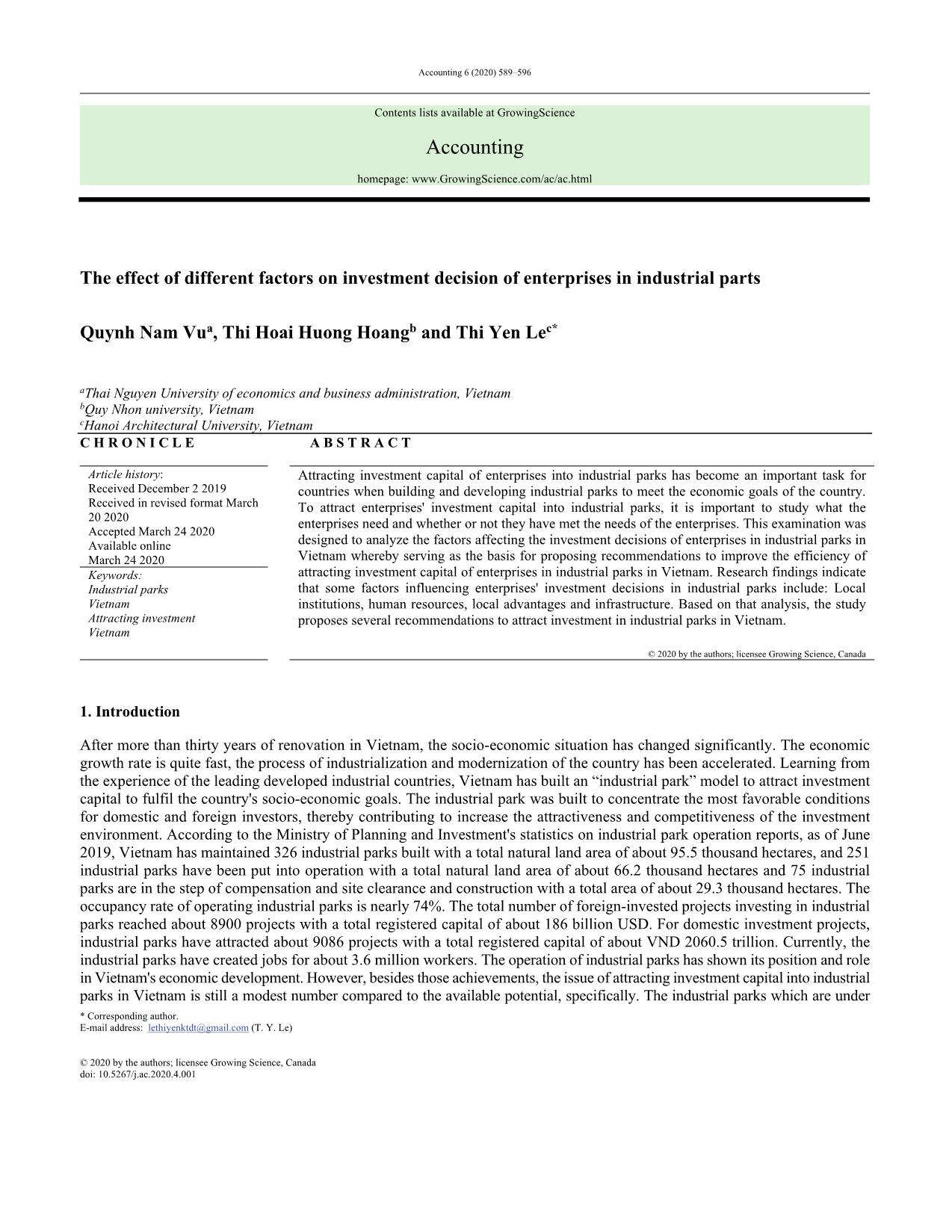
Trang 1
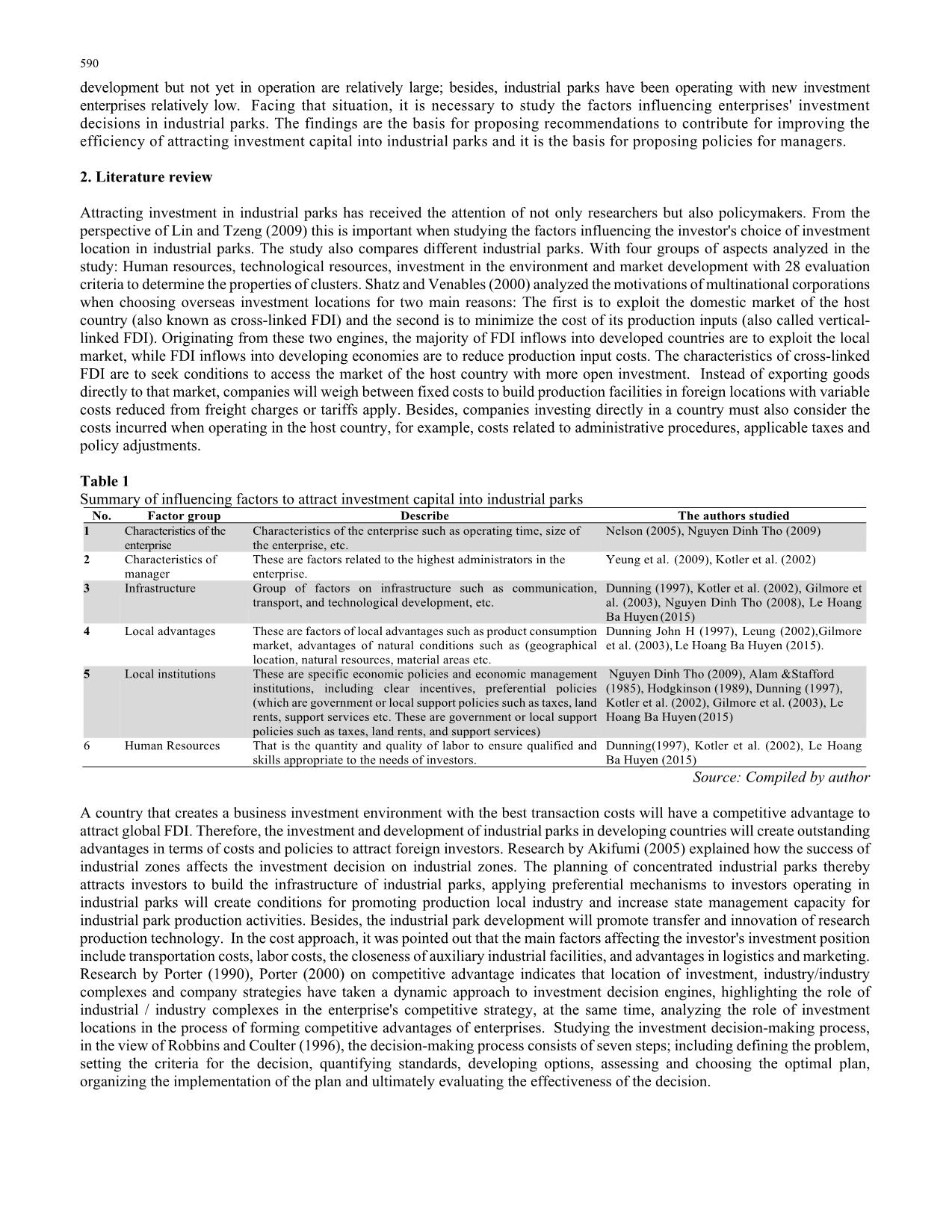
Trang 2

Trang 3
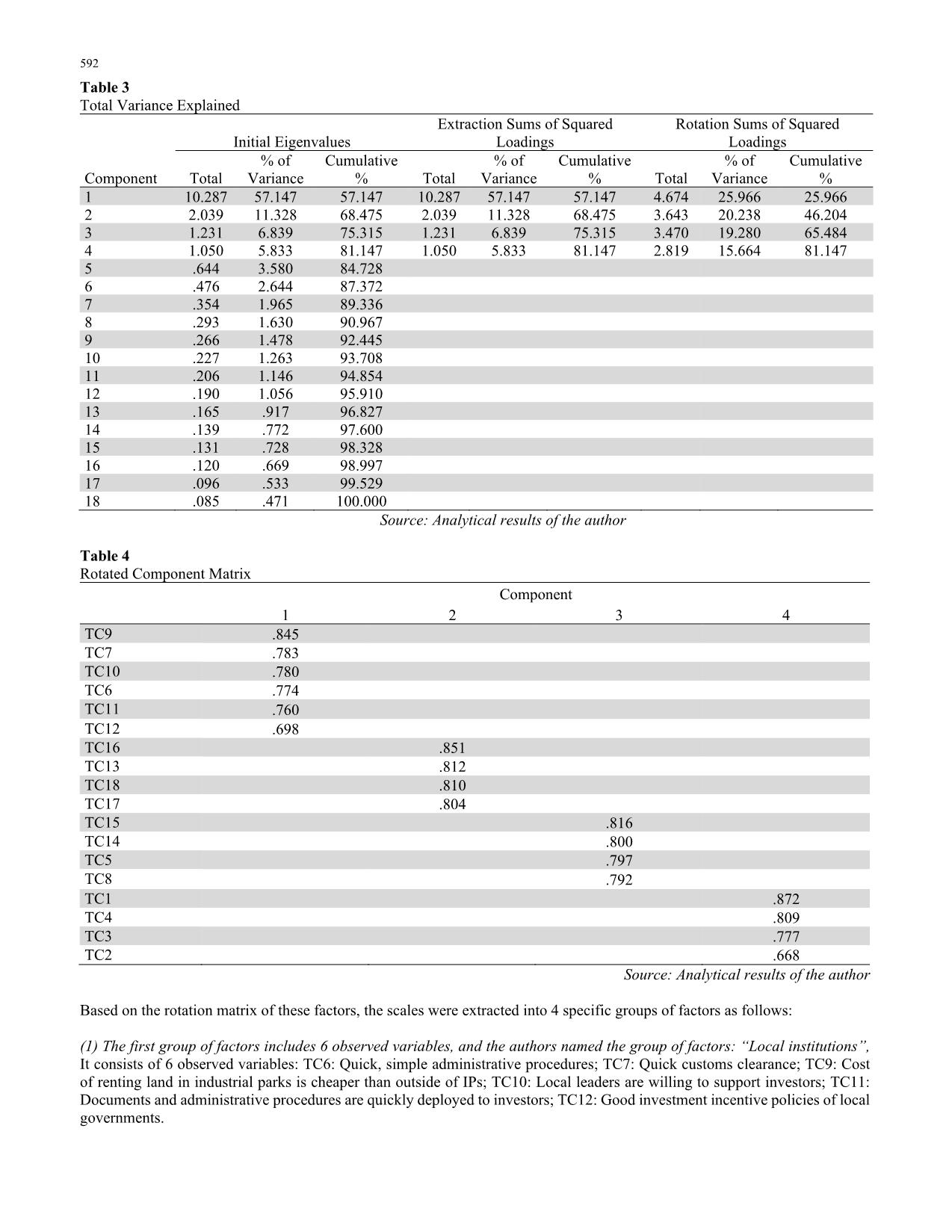
Trang 4
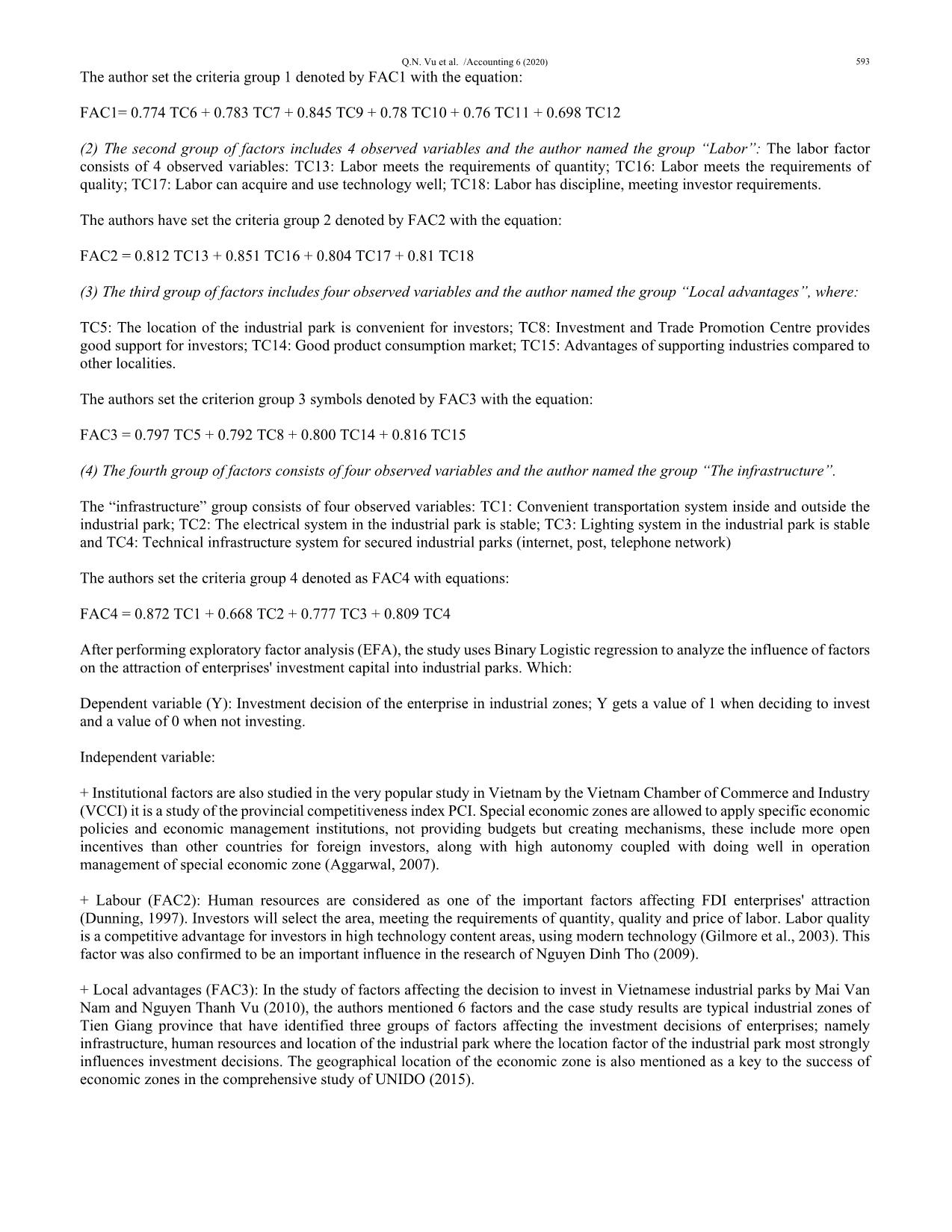
Trang 5
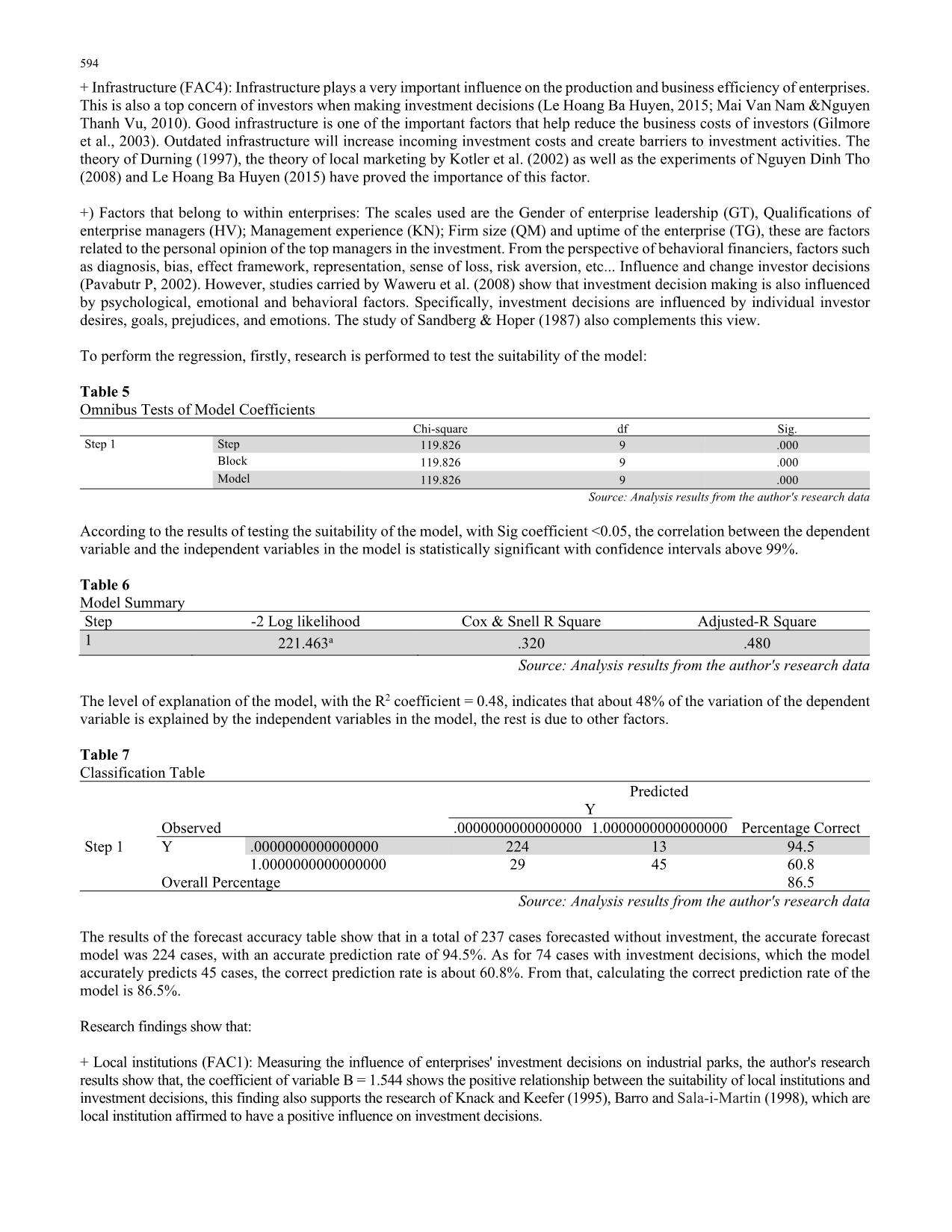
Trang 6
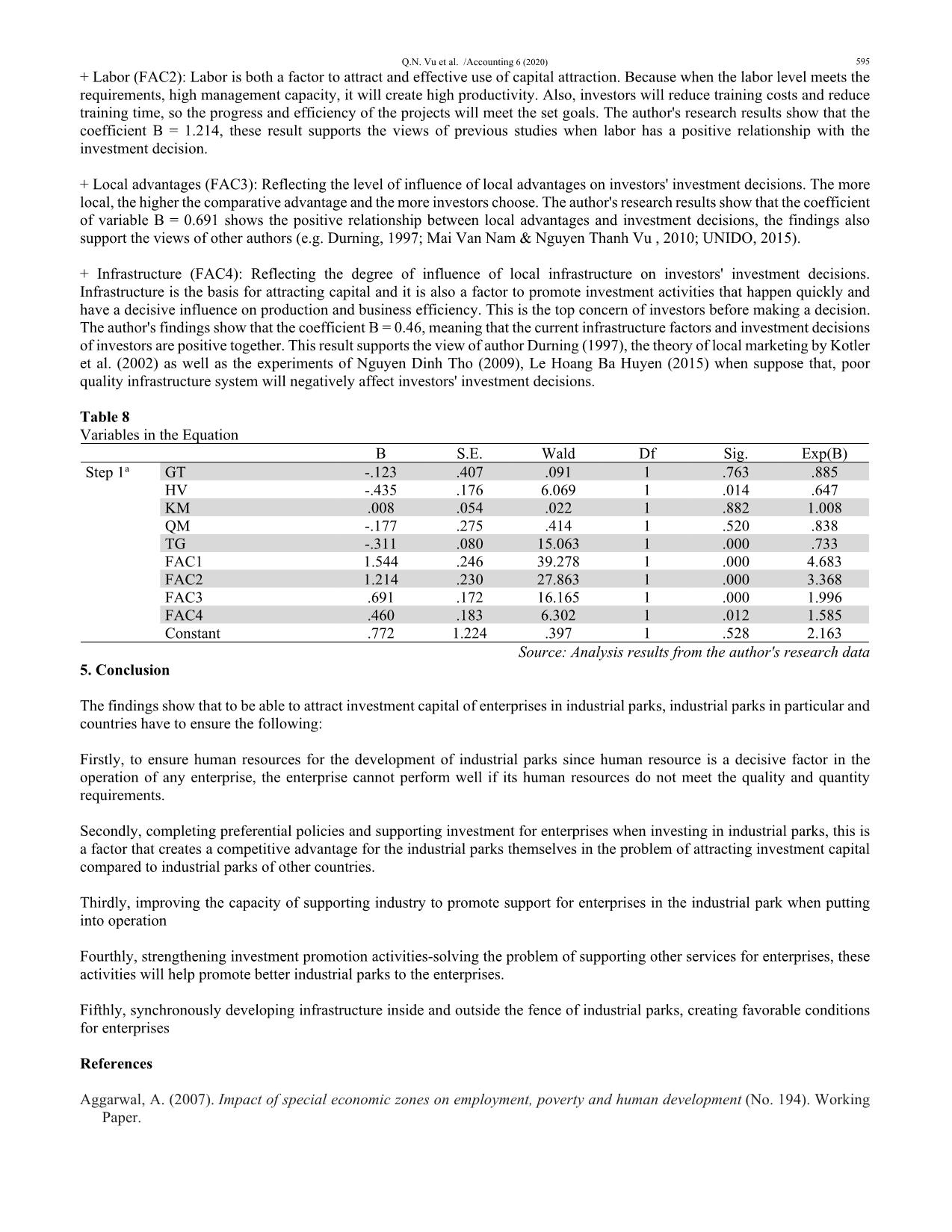
Trang 7
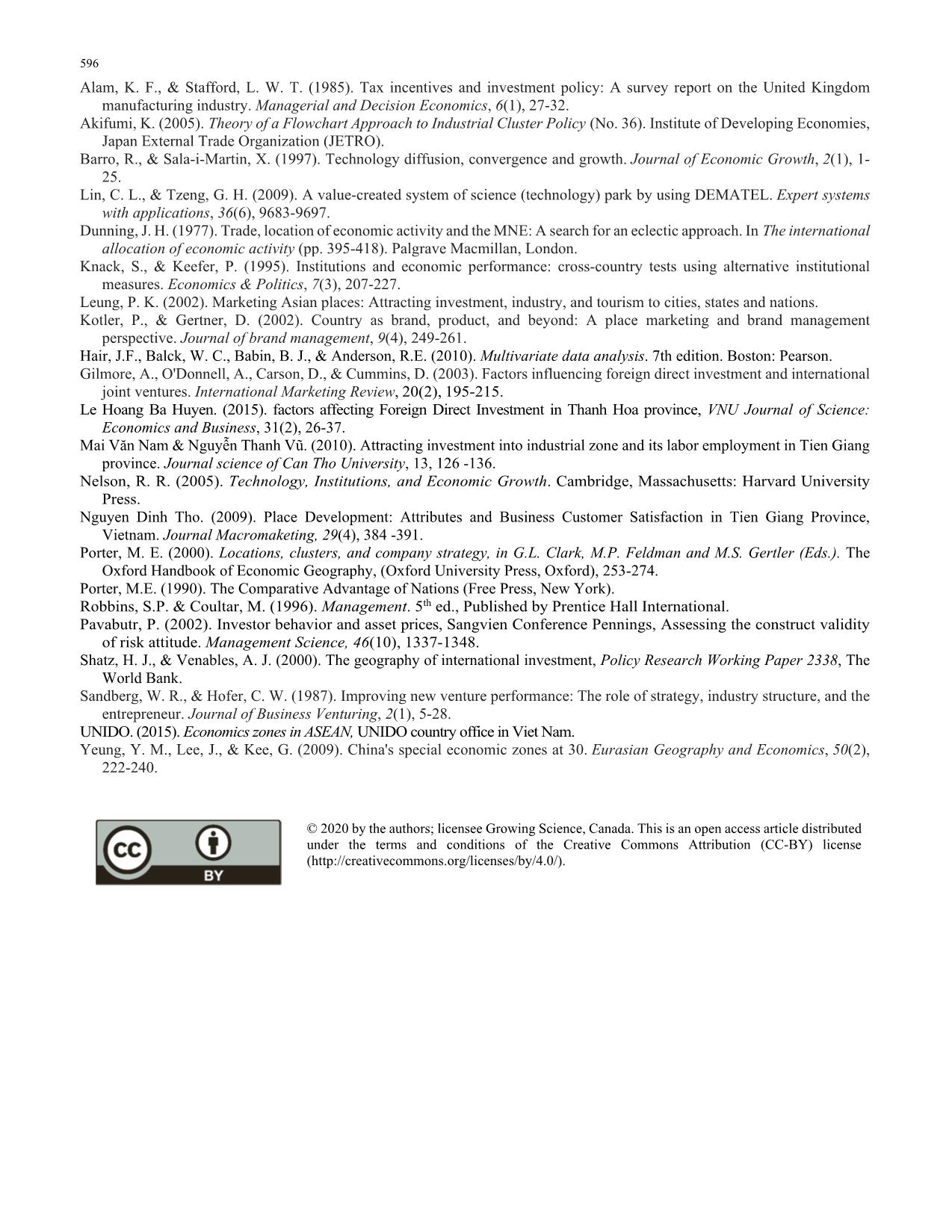
Trang 8
Tóm tắt nội dung tài liệu: The effect of different factors on investment decision of enterprises in industrial parts
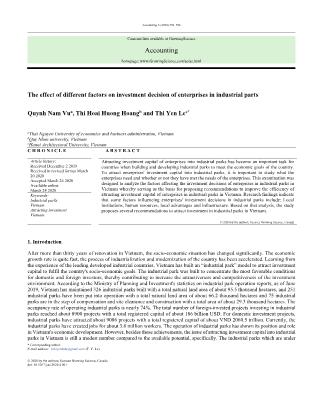
factors includes 4 observed variables and the author named the group “Labor”: The labor factor consists of 4 observed variables: TC13: Labor meets the requirements of quantity; TC16: Labor meets the requirements of quality; TC17: Labor can acquire and use technology well; TC18: Labor has discipline, meeting investor requirements. The authors have set the criteria group 2 denoted by FAC2 with the equation: FAC2 = 0.812 TC13 + 0.851 TC16 + 0.804 TC17 + 0.81 TC18 (3) The third group of factors includes four observed variables and the author named the group “Local advantages”, where: TC5: The location of the industrial park is convenient for investors; TC8: Investment and Trade Promotion Centre provides good support for investors; TC14: Good product consumption market; TC15: Advantages of supporting industries compared to other localities. The authors set the criterion group 3 symbols denoted by FAC3 with the equation: FAC3 = 0.797 TC5 + 0.792 TC8 + 0.800 TC14 + 0.816 TC15 (4) The fourth group of factors consists of four observed variables and the author named the group “The infrastructure”. The “infrastructure” group consists of four observed variables: TC1: Convenient transportation system inside and outside the industrial park; TC2: The electrical system in the industrial park is stable; TC3: Lighting system in the industrial park is stable and TC4: Technical infrastructure system for secured industrial parks (internet, post, telephone network) The authors set the criteria group 4 denoted as FAC4 with equations: FAC4 = 0.872 TC1 + 0.668 TC2 + 0.777 TC3 + 0.809 TC4 After performing exploratory factor analysis (EFA), the study uses Binary Logistic regression to analyze the influence of factors on the attraction of enterprises' investment capital into industrial parks. Which: Dependent variable (Y): Investment decision of the enterprise in industrial zones; Y gets a value of 1 when deciding to invest and a value of 0 when not investing. Independent variable: + Institutional factors are also studied in the very popular study in Vietnam by the Vietnam Chamber of Commerce and Industry (VCCI) it is a study of the provincial competitiveness index PCI. Special economic zones are allowed to apply specific economic policies and economic management institutions, not providing budgets but creating mechanisms, these include more open incentives than other countries for foreign investors, along with high autonomy coupled with doing well in operation management of special economic zone (Aggarwal, 2007). + Labour (FAC2): Human resources are considered as one of the important factors affecting FDI enterprises' attraction (Dunning, 1997). Investors will select the area, meeting the requirements of quantity, quality and price of labor. Labor quality is a competitive advantage for investors in high technology content areas, using modern technology (Gilmore et al., 2003). This factor was also confirmed to be an important influence in the research of Nguyen Dinh Tho (2009). + Local advantages (FAC3): In the study of factors affecting the decision to invest in Vietnamese industrial parks by Mai Van Nam and Nguyen Thanh Vu (2010), the authors mentioned 6 factors and the case study results are typical industrial zones of Tien Giang province that have identified three groups of factors affecting the investment decisions of enterprises; namely infrastructure, human resources and location of the industrial park where the location factor of the industrial park most strongly influences investment decisions. The geographical location of the economic zone is also mentioned as a key to the success of economic zones in the comprehensive study of UNIDO (2015). 594 + Infrastructure (FAC4): Infrastructure plays a very important influence on the production and business efficiency of enterprises. This is also a top concern of investors when making investment decisions (Le Hoang Ba Huyen, 2015; Mai Van Nam &Nguyen Thanh Vu, 2010). Good infrastructure is one of the important factors that help reduce the business costs of investors (Gilmore et al., 2003). Outdated infrastructure will increase incoming investment costs and create barriers to investment activities. The theory of Durning (1997), the theory of local marketing by Kotler et al. (2002) as well as the experiments of Nguyen Dinh Tho (2008) and Le Hoang Ba Huyen (2015) have proved the importance of this factor. +) Factors that belong to within enterprises: The scales used are the Gender of enterprise leadership (GT), Qualifications of enterprise managers (HV); Management experience (KN); Firm size (QM) and uptime of the enterprise (TG), these are factors related to the personal opinion of the top managers in the investment. From the perspective of behavioral financiers, factors such as diagnosis, bias, effect framework, representation, sense of loss, risk aversion, etc... Influence and change investor decisions (Pavabutr P, 2002). However, studies carried by Waweru et al. (2008) show that investment decision making is also influenced by psychological, emotional and behavioral factors. Specifically, investment decisions are influenced by individual investor desires, goals, prejudices, and emotions. The study of Sandberg & Hoper (1987) also complements this view. To perform the regression, firstly, research is performed to test the suitability of the model: Table 5 Omnibus Tests of Model Coefficients Chi-square df Sig. Step 1 Step 119.826 9 .000 Block 119.826 9 .000 Model 119.826 9 .000 Source: Analysis results from the author's research data According to the results of testing the suitability of the model, with Sig coefficient <0.05, the correlation between the dependent variable and the independent variables in the model is statistically significant with confidence intervals above 99%. Table 6 Model Summary Step -2 Log likelihood Cox & Snell R Square Adjusted-R Square 1 221.463a .320 .480 Source: Analysis results from the author's research data The level of explanation of the model, with the R2 coefficient = 0.48, indicates that about 48% of the variation of the dependent variable is explained by the independent variables in the model, the rest is due to other factors. Table 7 Classification Table Observed Predicted Y Percentage Correct .0000000000000000 1.0000000000000000 Step 1 Y .0000000000000000 224 13 94.5 1.0000000000000000 29 45 60.8 Overall Percentage 86.5 Source: Analysis results from the author's research data The results of the forecast accuracy table show that in a total of 237 cases forecasted without investment, the accurate forecast model was 224 cases, with an accurate prediction rate of 94.5%. As for 74 cases with investment decisions, which the model accurately predicts 45 cases, the correct prediction rate is about 60.8%. From that, calculating the correct prediction rate of the model is 86.5%. Research findings show that: + Local institutions (FAC1): Measuring the influence of enterprises' investment decisions on industrial parks, the author's research results show that, the coefficient of variable B = 1.544 shows the positive relationship between the suitability of local institutions and investment decisions, this finding also supports the research of Knack and Keefer (1995), Barro and Sala-i-Martin (1998), which are local institution affirmed to have a positive influence on investment decisions. Q.N. Vu et al. /Accounting 6 (2020) 595 + Labor (FAC2): Labor is both a factor to attract and effective use of capital attraction. Because when the labor level meets the requirements, high management capacity, it will create high productivity. Also, investors will reduce training costs and reduce training time, so the progress and efficiency of the projects will meet the set goals. The author's research results show that the coefficient B = 1.214, these result supports the views of previous studies when labor has a positive relationship with the investment decision. + Local advantages (FAC3): Reflecting the level of influence of local advantages on investors' investment decisions. The more local, the higher the comparative advantage and the more investors choose. The author's research results show that the coefficient of variable B = 0.691 shows the positive relationship between local advantages and investment decisions, the findings also support the views of other authors (e.g. Durning, 1997; Mai Van Nam & Nguyen Thanh Vu , 2010; UNIDO, 2015). + Infrastructure (FAC4): Reflecting the degree of influence of local infrastructure on investors' investment decisions. Infrastructure is the basis for attracting capital and it is also a factor to promote investment activities that happen quickly and have a decisive influence on production and business efficiency. This is the top concern of investors before making a decision. The author's findings show that the coefficient B = 0.46, meaning that the current infrastructure factors and investment decisions of investors are positive together. This result supports the view of author Durning (1997), the theory of local marketing by Kotler et al. (2002) as well as the experiments of Nguyen Dinh Tho (2009), Le Hoang Ba Huyen (2015) when suppose that, poor quality infrastructure system will negatively affect investors' investment decisions. Table 8 Variables in the Equation B S.E. Wald Df Sig. Exp(B) Step 1a GT -.123 .407 .091 1 .763 .885 HV -.435 .176 6.069 1 .014 .647 KM .008 .054 .022 1 .882 1.008 QM -.177 .275 .414 1 .520 .838 TG -.311 .080 15.063 1 .000 .733 FAC1 1.544 .246 39.278 1 .000 4.683 FAC2 1.214 .230 27.863 1 .000 3.368 FAC3 .691 .172 16.165 1 .000 1.996 FAC4 .460 .183 6.302 1 .012 1.585 Constant .772 1.224 .397 1 .528 2.163 Source: Analysis results from the author's research data 5. Conclusion The findings show that to be able to attract investment capital of enterprises in industrial parks, industrial parks in particular and countries have to ensure the following: Firstly, to ensure human resources for the development of industrial parks since human resource is a decisive factor in the operation of any enterprise, the enterprise cannot perform well if its human resources do not meet the quality and quantity requirements. Secondly, completing preferential policies and supporting investment for enterprises when investing in industrial parks, this is a factor that creates a competitive advantage for the industrial parks themselves in the problem of attracting investment capital compared to industrial parks of other countries. Thirdly, improving the capacity of supporting industry to promote support for enterprises in the industrial park when putting into operation Fourthly, strengthening investment promotion activities-solving the problem of supporting other services for enterprises, these activities will help promote better industrial parks to the enterprises. Fifthly, synchronously developing infrastructure inside and outside the fence of industrial parks, creating favorable conditions for enterprises References Aggarwal, A. (2007). Impact of special economic zones on employment, poverty and human development (No. 194). Working Paper. 596 Alam, K. F., & Stafford, L. W. T. (1985). Tax incentives and investment policy: A survey report on the United Kingdom manufacturing industry. Managerial and Decision Economics, 6(1), 27-32. Akifumi, K. (2005). Theory of a Flowchart Approach to Industrial Cluster Policy (No. 36). Institute of Developing Economies, Japan External Trade Organization (JETRO). Barro, R., & Sala-i-Martin, X. (1997). Technology diffusion, convergence and growth. Journal of Economic Growth, 2(1), 1- 25. Lin, C. L., & Tzeng, G. H. (2009). A value-created system of science (technology) park by using DEMATEL. Expert systems with applications, 36(6), 9683-9697. Dunning, J. H. (1977). Trade, location of economic activity and the MNE: A search for an eclectic approach. In The international allocation of economic activity (pp. 395-418). Palgrave Macmillan, London. Knack, S., & Keefer, P. (1995). Institutions and economic performance: cross‐country tests using alternative institutional measures. Economics & Politics, 7(3), 207-227. Leung, P. K. (2002). Marketing Asian places: Attracting investment, industry, and tourism to cities, states and nations. Kotler, P., & Gertner, D. (2002). Country as brand, product, and beyond: A place marketing and brand management perspective. Journal of brand management, 9(4), 249-261. Hair, J.F., Balck, W. C., Babin, B. J., & Anderson, R.E. (2010). Multivariate data analysis. 7th edition. Boston: Pearson. Gilmore, A., O'Donnell, A., Carson, D., & Cummins, D. (2003). Factors influencing foreign direct investment and international joint ventures. International Marketing Review, 20(2), 195-215. Le Hoang Ba Huyen. (2015). factors affecting Foreign Direct Investment in Thanh Hoa province, VNU Journal of Science: Economics and Business, 31(2), 26-37. Mai Văn Nam & Nguyễn Thanh Vũ. (2010). Attracting investment into industrial zone and its labor employment in Tien Giang province. Journal science of Can Tho University, 13, 126 -136. Nelson, R. R. (2005). Technology, Institutions, and Economic Growth. Cambridge, Massachusetts: Harvard University Press. Nguyen Dinh Tho. (2009). Place Development: Attributes and Business Customer Satisfaction in Tien Giang Province, Vietnam. Journal Macromaketing, 29(4), 384 -391. Porter, M. E. (2000). Locations, clusters, and company strategy, in G.L. Clark, M.P. Feldman and M.S. Gertler (Eds.). The Oxford Handbook of Economic Geography, (Oxford University Press, Oxford), 253-274. Porter, M.E. (1990). The Comparative Advantage of Nations (Free Press, New York). Robbins, S.P. & Coultar, M. (1996). Management. 5th ed., Published by Prentice Hall International. Pavabutr, P. (2002). Investor behavior and asset prices, Sangvien Conference Pennings, Assessing the construct validity of risk attitude. Management Science, 46(10), 1337-1348. Shatz, H. J., & Venables, A. J. (2000). The geography of international investment, Policy Research Working Paper 2338, The World Bank. Sandberg, W. R., & Hofer, C. W. (1987). Improving new venture performance: The role of strategy, industry structure, and the entrepreneur. Journal of Business Venturing, 2(1), 5-28. UNIDO. (2015). Economics zones in ASEAN, UNIDO country office in Viet Nam. Yeung, Y. M., Lee, J., & Kee, G. (2009). China's special economic zones at 30. Eurasian Geography and Economics, 50(2), 222-240. © 2020 by the authors; licensee Growing Science, Canada. This is an open access article distributed under the terms and conditions of the Creative Commons Attribution (CC-BY) license (
File đính kèm:
 the_effect_of_different_factors_on_investment_decision_of_en.pdf
the_effect_of_different_factors_on_investment_decision_of_en.pdf

